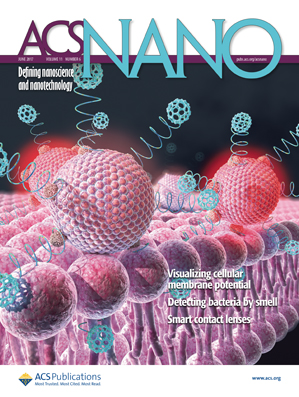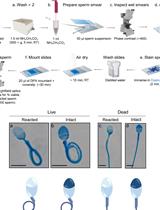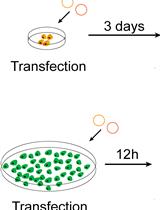- EN - English
- CN - 中文
A General Method for Intracellular Protein Delivery through ‘E-tag’ Protein Engineering and Arginine Functionalized Gold Nanoparticles
通过'E标签'蛋白质工程和精氨酸功能化金纳米粒子进行细胞内蛋白质递送的通用方法
发布: 2017年12月20日第7卷第24期 DOI: 10.21769/BioProtoc.2661 浏览次数: 8213
评审: Renate WeizbauerPia GiovannelliYang Fu
Abstract
In this protocol, we describe a method for direct cytosolic protein delivery that avoids endosomal entrapment of the delivered proteins. We achieved this by tagging the desired protein with an oligo glutamic acid tag (E-tag), and subsequently using carrier gold nanoparticles to deliver these E-tagged proteins. When E-tagged proteins and nanoparticles were mixed, they formed nanoassemblies, which got fused to cell membrane upon incubation and directly released the E-tagged protein into cell cytosol. We used this method to deliver a wide variety of proteins with different sizes, charges, and functions in various cell lines (Mout et al., 2017).
To use this protocol, the first step is to generate the required materials (gold nanoparticles, recombinant E-tagged proteins). Laboratory-synthesis of gold nanoparticles has been previously described (Yang et al., 2011). Desired E-tagged proteins can be cloned from the corresponding genes, and expressed and purified using standard laboratory procedures. We will use E-tagged green fluorescent protein (GFP) as a reference protein here. Users can simply insert an E-tag into their protein of interest, at either terminus. To achieve maximum delivery efficiency, we suggest users testing different length of E-tags. For example, we inserted E = 0 to 20 (E0 means no E-tag insertion, and E20 means 20 glutamic acids insertion in a row) to most of the proteins we tested, and screened for optimal E-tagged length for highest delivery efficiency. E10-tagged proteins gave us the highest delivery efficiency for most of the proteins (except for Cas9, where E20 tag showed highest delivery efficiency).
Once these materials are ready, it takes about ~10 min to make the E-tagged protein and nanoparticle nanoassemblies, which are immediately used for delivery. Complete delivery (~100% for GFP-E10) is achieved in less than 3 h.
Background
Intracellular delivery of exogenous proteins into cells is crucial for cellular imaging and diagnosis, therapeutic development, genome engineering and synthetic biology applications (Fu et al., 2014). Many of the applications in cellular engineering and imaging (such as genome editing, cellular imaging) require delivering exogenous proteins, as mammalian cells do not have genes for those proteins. However, access to the whole cytoplasm by the delivered protein remains elusive. A major hurdle in cytoplasmic protein delivery is the endosomal entrapment of the delivered cargo: nanocarrier-based delivery methods result in only a fraction of the entrapped cargo (often ~1%) escaping into the cytosol (Stewart et al., 2016). Additionally, protease-mediated degradation and exocytosis of the remaining entrapped cargo proteins make these strategies ultimately inefficient. Delivery through membrane disruption methods can provide efficient cytosolic protein delivery; however, these methods generally require additional osmolytic surfactants (Erazo-Oliveras et al., 2014), hypertonic agents (D’Astolfo et al., 2015), or mechanical distortion techniques (Han et al., 2015) that may be harmful for the cells. Our protocol provides an approach for direct cytosolic delivery of a desired protein for applications including cellular imaging and basic cell biology research (Mout et al., 2017).
Materials and Reagents
- Round bottom 35 mm confocal dish (MATTEK, catalog number: P35G-0-14-C )
- 24-well plates (Corning, Costar®, catalog number: 3524 )
- Sterile tubes (0.6, 1.5, and/or 2.0 ml) (Fisherbrand)
- Sterile pipette tips (white, yellow and blue tips)
- Cell lines (i.e., HeLa)
- 1x Phosphate buffered saline (PBS) (GE Healthcare, HyCloneTM, catalog number: SH30028.02 )
- Plain DMEM media (No serum and antibiotics) (Thermo Fisher Scientific, GibcoTM, catalog number: 10567014 )
- Appropriate media for cell culture (i.e., HeLa cells, DMEM, Thermo Fisher Scientific, GibcoTM, catalog number: 10567014 )
- Alexa Fluor 488 NHS Ester (Thermo Fisher Scientific, InvitrogenTM, catalog number: A20000 )
- Stock solution of ArgNP gold nanoparticles (~50 μM in water, laboratory synthesized)
- E-tagged proteins (laboratory purified)
Equipment
- Pipettes (P2, P10, P20, P200, P1000)
- BSL-2 safety cabinet for cell culture
- Cell culture incubator at 5% CO2 and 37 °C
- Confocal microscope (any brand)
- Flow cytometer (i.e., BD, model: LSR II )
Procedure
文章信息
版权信息
© 2017 The Authors; exclusive licensee Bio-protocol LLC.
如何引用
Mout, R. and Rotello, V. M. (2017). A General Method for Intracellular Protein Delivery through ‘E-tag’ Protein Engineering and Arginine Functionalized Gold Nanoparticles. Bio-protocol 7(24): e2661. DOI: 10.21769/BioProtoc.2661.
分类
生物化学 > 蛋白质 > 标记
您对这篇实验方法有问题吗?
在此处发布您的问题,我们将邀请本文作者来回答。同时,我们会将您的问题发布到Bio-protocol Exchange,以便寻求社区成员的帮助。
Share
Bluesky
X
Copy link














